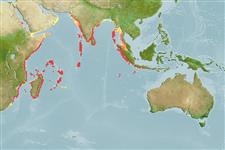>
Mulliformes (Goatfishes) >
Mullidae (Goatfishes)
Etymology: Parupeneus: Latin, parum, parvum = small + Peneus, the name of a river.
More on author: Lacepède.
Environment: milieu / climate zone / depth range / distribution range
Ecologia
marinhas associadas(os) a recifes; intervalo de profundidade 0 - 80 m (Ref. 1602). Tropical; 24°N - 33°S, 28°E - 112°E
Indian Ocean: Oman and East Africa south to South Africa and east to Christmas Island and Java, Indonesia.
Included in the Parupeneus trifasciatus complex are: Parupeneus trifasciatus from the Indian Ocean; Parupeneus crassilabris from eastern Indian Ocean and the western Pacific, east to Fiji, Tonga, and the Caroline Islands; and Parupeneus insularis from the more eastern islands of Oceania.
Tamanho / Peso / Idade
Maturity: Lm ? range ? - ? cm
Max length : 35.0 cm TL macho/indeterminado; (Ref. 30573); common length : 27.0 cm TL macho/indeterminado; (Ref. 30573); peso máx. publicado: 656.00 g (Ref. 125599)
Espinhos dorsais (total): 8; Raios dorsais (total): 9; Espinhos anais 1; Raios anais : 7.
This occasionally schooling species inhabits lagoon and seaward reefs: juveniles on reef flats, adults tend to occur around rocky or coralline areas of high vertical relief. Feeds on crustaceans at daytime and on fishes and crab larvae at night. Also feeds on worms (Ref. 6113). Occurs in 3 color forms. The Indian Ocean form has 2 sharply defined wedge-shaped bars become narrower and sometimes end on the belly. The Indo-Australian form has 3 very distinct dark patches and rows of yellow spots on the sides. The Pacific Plate form has 2 wide bars that extend to the belly (Ref. 37816). Minimum depth reported taken from Ref. 128797.
Ciclo de vida ou comportamento de acasalamento
Maturidade | Reprodução | Desova | Ovos | Fecundidade | Larvas
Randall, J.E. and R.F. Myers, 2002. Parupeneus insularis, a new central pacific species of goatfish (Perciformes:Mullidae) of the P. trifasciatus complex. Zool. Stud. 41(4):431-440. (Ref. 45589)
Status na Lista Vermelha da UICN (Ref. 130435)
Ameaça para os humanos
Harmless
Uso pelos humanos
Pescarias: espécies comerciais
Mais informação
ReferênciasAquaculturaPerfil para aquaculturaEstirpesGenéticaElectrophoresesHereditariedadeDoençasProcessamentoNutrientsConversão de massa
Ferramentas
Relatórios especiais
Baixar XML
Fontes da internet
Estimates based on models
Preferred temperature (Ref.
123201): 23.6 - 29, mean 27.8 °C (based on 1364 cells).
Índice de diversidade filogenética (Ref.
82804): PD
50 = 0.5000 [Uniqueness, from 0.5 = low to 2.0 = high].
Bayesian length-weight: a=0.00813 (0.00535 - 0.01235), b=3.18 (3.06 - 3.30), in cm total length, based on LWR estimates for this species & Genus-body shape (Ref.
93245).
Nível Trófico (Ref.
69278): 3.5 ±0.50 se; based on food items.
Resiliência (Ref.
120179): médio(a), tempo mínimo de duplicação da população 1,4 - 4,4 anos (Preliminary K or Fecundity.).
Fishing Vulnerability (Ref.
59153): Low vulnerability (25 of 100).
Nutrients (Ref.
124155): Calcium = 33.2 [16.8, 74.0] mg/100g; Iron = 0.307 [0.155, 0.679] mg/100g; Protein = 17.9 [14.5, 20.9] %; Omega3 = 0.128 [0.073, 0.231] g/100g; Selenium = 56 [27, 128] μg/100g; VitaminA = 195 [39, 810] μg/100g; Zinc = 0.531 [0.319, 1.009] mg/100g (wet weight); based on
nutrient studies.
